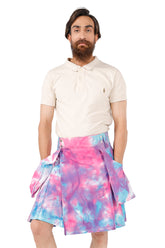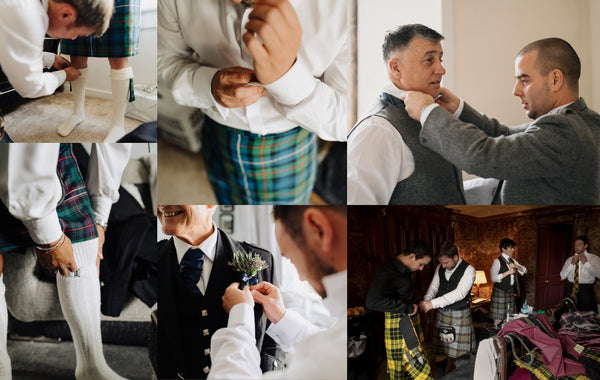How To Take Care of Your Kilt | The Complete Guide
The kilt is a timeless piece of clothing with a rich history. Though its origin is unknown, the kilt is thought to have originated in the Scottish Highlands. Today, the kilt is worn by people all over the world as a symbol of Scottish heritage. The kilt is a versatile piece of clothing that can be dressed up or down. It can be worn for formal occasions, such as weddings, or for more casual occasions, such as going to the pub. Regardless of how it is worn, the kilt should always be treated with care to ensure that it lasts for many years.
In this guide, we will cover everything you need to know about taking care of your kilt. We will discuss the history of the kilt and how it is worn, how to find and shop for the perfect kilt, tips for avoiding kilt damage in daily life, maintaining a clean and smelling kilt, how to wear your kilts over time, and more. By the end of this guide, you will be an expert in taking care of your kilt and ensuring that it looks great for years to come.
The History of the Kilt and How it is Worn
The kilt is a traditional garment that originated in the Scottish Highlands. It is typically made of wool or tartan and is fastened at the waist with a belt. The kilt is worn by both men and women and is often seen as a symbol of Scottish culture and heritage.
The history of the kilt is long and complex, dating back to the 16th century. The first recorded use of the word “kilt” was in 1594, but it is believed that the garment has been around for much longer. It is thought that the kilt was originally worn as a form of body armor by Highland warriors. The fabric would be wrapped around the body and fastened at the waist, providing protection from enemy weapons.
Over time, the kilt became more than just a piece of functional clothing; it came to represent Scottish identity and pride. Today, kilts are worn by Scots all over the world as a way to connect with their heritage. They are also commonly worn at formal occasions, such as weddings and graduations.
How to Find & Shop for the Perfect Kilt
When shopping for a Tartan kilt or any type of kilt, it is important to keep in mind that not all kilts are created equal. There are many different factors that go into making a quality kilt, from the fabric to the stitching. Here are a few things to keep in mind when shopping for your perfect kilt:
- The fabric is the most important factor in determining the quality of a Kilt. The best fabrics for kilts are wool, linen, and cotton. Avoid polyester or acrylic fabrics, as they will not breathe as well and can be uncomfortable to wear.
- The stitching should be tight and even, with no loose threads. The pleats should also be evenly spaced and lie flat against the fabric.
- The kilt should be cut to fit your body snugly, but not so tight that it is uncomfortable. Kilts are typically worn at the natural waist, so make sure to try them on in this position.
- The kilt should come with all the necessary accessories, such as a sporran (pouch), belt, and kilt pin. These items can often be purchased separately, but it is usually more convenient to buy them as a set.
- Finally, make sure to choose a kilt that fits your personal style. There are many different tartans and plaids to choose from, so take your time in picking one that you love.
Tips for Avoiding Kilt Damage in Daily Life
When it comes to taking care of your kilt, there are a few things you can do to help keep it in good condition. Here are some tips for avoiding kilt damage in daily life:
- Be careful when putting on and taking off your kilt. Avoid snagging the fabric on sharp objects or pulling too hard when putting it on or taking it off.
- Be mindful of what you sit on. Avoid sitting on rough surfaces that could damage the fabric. If you're going to be sitting on the ground, consider using a blanket or towel to protect your kilt.
- Be cautious when around food and drink. Spills can easily damage a kilt, so try to avoid them if possible. If you do get a spill on your kilt, blot it up as soon as possible to avoid staining.
- Take care when washing your kilt. Avoid using harsh detergents or scrubbing too vigorously, which could damage the fabric. Instead, opt for a mild detergent and hand-wash if possible.
- Store your kilt properly when not in use. Fold it neatly and store it in a cool, dry place out of direct sunlight to avoid fading or damage from heat or moisture.
Maintaining a Clean and Smelling Kilt
"Maintaining a clean and smelling kilt is important for two reasons: first because it is a reflection of you and second because it will last longer. Here are some tips on how to keep your kilt clean and smelling great.
- Always hang your kilt up after wearing it. This will allow the fabric to air out and prevent wrinkles.
- If your kilt gets wet, hang it up to dry as soon as possible. Wet fabric can mildew and cause permanent damage.
- Spot-clean your kilt as needed using mild detergent and cool water. Be sure to rinse the fabric thoroughly to remove all soap residue.
- Have your kilt professionally cleaned at least once a year? This will remove any built-up dirt and grime and help extend the life of the fabric.
- Store your kilt in a cool, dry place when not in use. Avoid storing it in direct sunlight or in a humid environment as this can cause the fabric to deteriorate."
How to Wear Your Kilts Over Time
As your Kilt begins to show signs of wear, it is important to take care of it so that it will last for many years. Here are some tips on how to wear your kilts over time:
- Be sure to rotate your kilt regularly. This will help to prevent the fabric from becoming worn in one spot.
- If you notice any fraying or other damage, be sure to have it repaired as soon as possible.
- When storing your kilt, be sure to fold it properly. This will help to prevent creases and wrinkles.
- If you plan on wearing your kilt for an extended period of time, be sure to take a break every few hours to allow the fabric to breathe.
- Be sure to follow the care instructions that came with your kilt. This will help to keep it looking its best.
Conclusion
As you can see, taking care of your kilt is not difficult, but it does require some effort. By following the tips in this guide, you can ensure that your kilt will last for many years to come. Thanks for reading!















